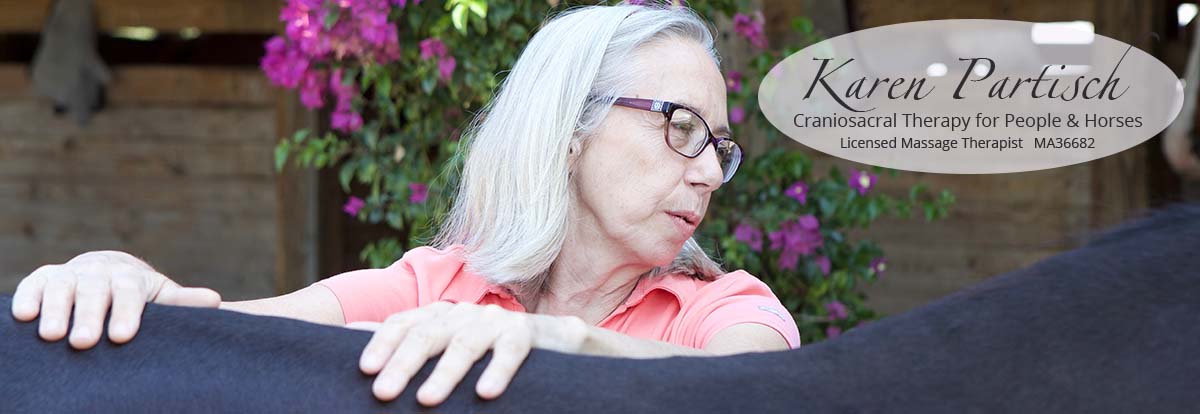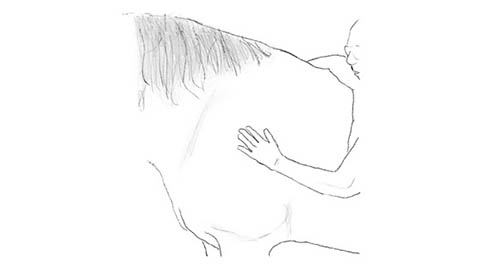Most of the horses I treat are healthy, happy horses. My treatments help these horses process their stress, release restrictions, mobilize fascia, improve fluid flow, and increase connection with their humans. They help relax their own nervous systems and upgrade performance, increasing Dynamic Balance.
Every once in a while, I get to treat a horse that has some unique set of circumstances that are baffling to their people. In years gone by, the vets would give them the ‘ADR’ diagnosis. We don’t know what’s wrong, but we know he ‘Ain’t Doing Right,’ hence the acronym ADR. In April, I got to treat a horse that fit that description.
This horse, I’ll call him ‘K’, is with a thoughtful dressage trainer who is committed to keeping horses happy and healthy first when learning their sport (my favorite kind of horse people!). They were in Ocala for the winter. In learning about K’s history, he had been through colic surgery that went well; however, something happened and he had really changed. The way he was described to me sounded like he was discombobulated. There is no evidence of pain or lameness, however, he can’t find comfortable gaits, finds it hard to maintain a good balance and will often express signs of nervousness simply standing in his stall. I know this trainer has a great toolbox of techniques to keep her horses relaxed, so this was very perplexing to both of us. I will admit I had to take a few long, slow breaths to keep me relaxed walking into this session.
Typically, the first time I treat a horse there is a fair amount of moving around, resistance, relaxation, resisting, calming, resisting ... and so the dance goes. Then as they begin to understand that I am asking them to relax and allowing them to do all their own work, they drop into treatment and the magic happens (Coming up against resistance, whether you have two legs or four, is always a challenge. A challenge that I value immensely.) There was a lot of resistance and uncertainty with K. I found myself repeatedly having to drop my energy even softer, ask lighter, always looking for a way to make it safer for him to connect. There was a lot of movement about the stall (a nice big stall where I was treating him). There was a lot of him keeping an eye on the other horses in the barn and other signs he was not feeling safe. And I just kept asking as politely as I could. It was my job to keep listening to his story as he was expressing his uncertainty. Allowing him to start to feel for safety.
Then began a beautiful connection, slowly developing, that is hard to put in words. It’s this dance with the energy and the spirit that is often where the magic of healing and transformation happens. I knew he was so uncomfortable in his skin, I could feel his lack of proprioception — that is the sense of self, self-movement and body position — and how frightening this was for him.
Eventually I ended up at his right front shoulder, treating a small area around his scapula. I was not sure why I was there, all I knew was that felt safe for him and we were starting to deeply connect. He stopped walking about his stall and started to experience moments of true relaxation. Those moments turned to minutes and then he found his place to drop in. In craniosacral terms, he was in a Still Point.
Another fun piece to this is as we got closer to K dropping in and finding his place to deeply relax, the horse in the stall next to us was standing with his head close to us and was dropping in to his own healing space. The deliciousness of herd energy.
As K found his way into relaxation, he stayed present with me, his eyes softened, his head and neck lowered, his ears relaxed. There were many beautiful signs of tissue release. I could feel him start to relax in a way that he has not been able to in quite some time. He felt safe. My responsibility to hold this safe space for him was huge and filled with empathy.
As the session came to completion, I did a little bit of rebalancing along his spine. And thanked not only him, but that amazing spot on the right shoulder for allowing me in and so much more. The horse I had at the end of the treatment was so different than the horse I met at the start.
I then went and found the trainer who was kind enough to give me the leadership role and not watch the session. (In this case, this was significant. It’s not always an issue and I appreciate her wisdom with this call.) As we walked back to the stalls, she commented (repeatedly) on two things. First, that she had never seen K look so relaxed and that all three of her horses (I was in the first stall with K and the next 2 stalls has her other horses) were all super relaxed. Low heads, all resting very quietly, soft ears and eyes and more. I will admit I was thrilled to see K so quiet in himself. Felt like the first time in a while that he felt that relaxed and safe. My heart was full.
Out of respect for this trainer’s time, I did not contact her for feedback. I assumed that if there were something I needed to know, she would reach out. We had rebooked for me to come back in two weeks and I knew I could hear all about him then.
Two weeks later, the trainer was teaching and would meet me at the barn. K was in his stall so I was to start without the trainer being there. I typically like to get feedback at this point to see what changed, what didn’t, what changes held and if she has a new intention for this treatment. That little voice in my gut told me I would know and didn’t need to ask.
As I walked up to K in his stall, I literally had to check that I had the correct horse. He looked like that same very tall, handsome 17h bay gelding and he looked completely different. He was standing there, he recognized me (which always makes my heart sing) and I knew it was K. It took me a while to fully grasp how changed he was. He was so much more relaxed, grounded, and fully present. To be completely honest, I checked four times that I had the right horse.
This session was as different as he was. This was all about welcoming him back to living in a comfortable body. There were a few areas that weren’t quite ready to let go of all the old tension patterns. We did some work around this and all I asked was that he entertain the thought of living without that tension. It really did feel like time would allow this to heal. This treatment was so much more typical of the treatments I do: Optimize Dynamic Balance by mobilizing fascia, increasing fluid flow, relaxing the nervous system and rebalancing where it is needed. K was in this, “I got this, we’re good” place that I love to feel. I knew his body would continue to process what was needed for him.
As I finished up, the trainer came back. She was so kind in her praise for the significance of the changes that K has made. She mentioned several of the many ways she has tried to help this horse without success. She also shared that they have been cantering in both directions now. Something seemly impossible and unsafe to do just two weeks ago.
The joy I felt for K and the gratitude I have for this work had me dancing and welling with tears at the same time.
K and his trainer are heading back to their home farm and out of the Florida heat. I look forward to hearing how he is doing in the future. And I am so grateful for this experience. I love my job.



 To Schedule a Session, contact Karen at
To Schedule a Session, contact Karen at